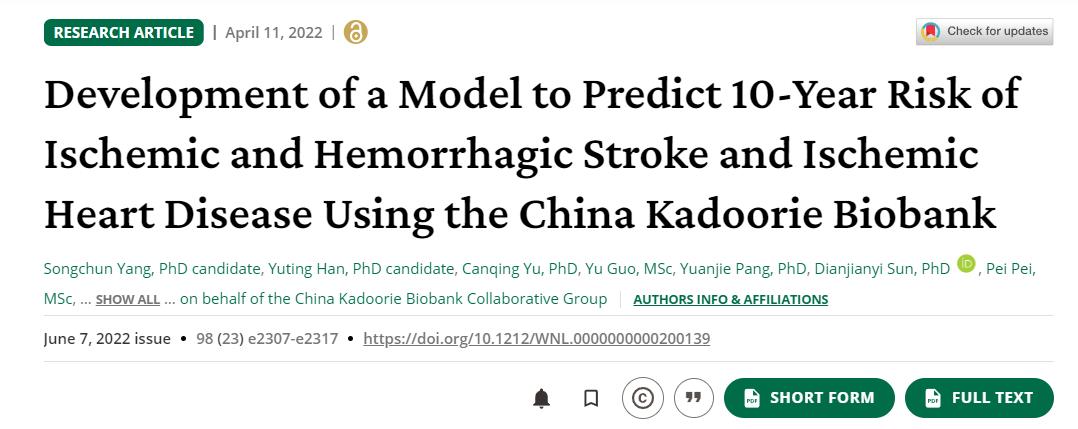Impact Factor:11.8
DOI number:10.1212/WNL.0000000000200139
Journal:Neurology
Key Words:Risk prediction model; Hemorrhagic Stroke; Ischemic Stroke; Ischemic Heart Disease; Chinese
Abstract:Background and objectives: Contemporary cardiovascular disease (CVD) risk prediction models are rarely applied in routine clinical practice in China due to substantial regional differences in absolute risks of major CVD types within China. Moreover, the inclusion of blood lipids in most risk prediction models also limits their use in the Chinese population. We developed 10-year CVD risk prediction models excluding blood lipids that may be applicable to diverse regions of China. Methods: We derived sex-specific models separately for ischemic heart disease (IHD), ischemic stroke (IS), and hemorrhagic stroke (HS) in addition to total CVD in the China Kadoorie Biobank. Participants were age 30-79 years without CVD at baseline. Predictors included age, systolic and diastolic blood pressure, use of blood pressure-lowering treatment, current daily smoking, diabetes, and waist circumference. Total CVD risks were combined in terms of conditional probability using the predicted risks of 3 submodels. Risk models were recalibrated in each region by 2 methods (practical and ideal) and risk prediction was estimated before and after recalibration. Results: Model derivation involved 489,596 individuals, including 45,947 IHD, 43,647 IS, and 11,168 HS cases during 11 years of follow-up. In women, the Harrell C was 0.732 (95% CI 0.706-0.758), 0.759 (0.738-0.779), and 0.803 (0.778-0.827) for IHD, IS, and HS, respectively. The Harrell C for total CVD was 0.734 (0.732-0.736), 0.754 (0.752-0.756), and 0.774 (0.772-0.776) for models before recalibration, after practical recalibration, and after ideal recalibration. The calibration performances improved after recalibration, with models after ideal recalibration showing the best model performances. The results for men were comparable to those for women. Discussion: Our CVD risk prediction models yielded good discrimination of IHD and stroke subtypes in addition to total CVD without including blood lipids. Flexible recalibration of our models for different regions could enable more widespread use using resident health records covering the overall Chinese population. Classification of evidence: This study provides Class I evidence that a prediction model incorporating accessible clinical variables predicts 10-year risk of IHD, IS, and HS in the Chinese population age 30-79 years.
Co-author:Yuting Han, Canqing Yu, Yu Guo, Yuanjie Pang, Dianjianyi Sun, Pei Pei, Ling Yang, Yiping Chen, Huaidong Du, Hao Wang, M. Sofia Massa, Derrick Bennett, Robert Clarke, Junshi Chen, Zhengming Chen, Liming Li, China Kadoorie Biobank Collaborative Group
First Author:Songchun Yang
Indexed by:Journal paper
Correspondence Author:Jun Lv
Document Code:PMID: 35410902
Discipline:Medicine
First-Level Discipline:Public Health and Preventive Medicine
Document Type:J
Volume:98
Issue:23
Page Number:e2307-e2317
ISSN No.:0028-3878
Translation or Not:no
Included Journals:SCI
Links to published journals:https://www.neurology.org/doi/10.1212/WNL.0000000000200139


